The Ancient Egyptian Pyramids
The Egyptian Pyramids are described as pyramid-shaped monuments, constructed mostly as funerary tombs and ceremonial complexes for the departed pharaohs during the Old Kingdom (2575 BC to 2150 BC) and Middle Kingdom (2050-1550 BC) periods.
To date, approximately 118 pyramids of various definitions have been discovered across Egypt (although sources differ with some citing 138), mainly sited on the west bank of the River Nile and grouped into several clusters or pyramid fields.
A later resurgence in pyramid construction took place in the Kingdom of Kush, after much of Egypt came under the rule of the Kushites. The Meroitic period, centred on the region of Meroë, also called the "Island of Meroë" (in modern-day Sudan) saw the construction of over two hundred pyramids across four pyramid clusters.
Pyramid construction evolved from mudbrick bench-like structures called mastabas (meaning "stone bench"), which were rectangular funerary structures with inward sloping sides, built mainly during the Early Dynastic Period.
Mastabas contained a burial chamber cut into the bedrock, often with a second chamber called a serdab to hold precious items and essentials needed for the deceased in the afterlife. After the emergence of pyramids, mastabas still continued to be built for high ranking officials and members of nobility into the Middle Kingdom, but were less common by the New Kingdom being largely superseded by rock-cut tombs.
The Step Pyramid (Original height 62.5 metres)
Subscribe to more articles like this by following our Google Discovery feed - Click the follow button on your desktop or the star button on mobile. Subscribe
The first proto-pyramid-like structure to evolve in Egypt was the Pyramid of Djoser (also known as the Step Pyramid) in the Saqqara necropolis during the 3rd Dynasty of the Old Kingdom. The Pyramid started as a square mastaba like structure (although arguably mastaba's are generally rectangular in shape) and was developed into a six-stepped monument with an underground labyrinth of chambers and galleries cut into the bedrock.
The Step pyramid was built as the funerary tomb of the pharaoh Djoser (the first pharaoh of the 3rd Dynasty) and the wider complex functioned to facilitate a successful afterlife for the pharaoh to be eternally reborn. The substructure consists of a labyrinth of tunnelled chambers and galleries for the pharaoh's burial, the burial of family members, and the storage of goods and offerings.
The Step Pyramid is arguable the first major monumental structure made of stone in Egypt that sets the stage for later pyramids of the 4th, 5th, and 6th Dynasties.

The Buried Pyramid (Original height 8 metres)
The next attempt at pyramid construction was by Sekhemkhet Djoserty, the second pharaoh of the 3rd Dynasty who constructed the Buried Pyramid – also called the Pyramid of Sekhemkhet at the Saqqara necropolis.
The Buried Pyramid was originally modelled after Djoser's Step Pyramid with the intention to be stepped right from inception and surpass its predecessor, but construction only managed to rise above ground level giving the appearance of a mastaba than an actual pyramid.
The substructure consists of 136 unfinished galleries which form a U shape around the pyramid that leads to the main burial chamber. Historians attribute the unfinished nature of the Buried Pyramid to Sekhemkhet's short reign as pharaoh.
The Layer Pyramid (Original height 42 metres)
Also, during the 3rd Dynasty, another step pyramid was constructed possibly by the pharaoh Khaba close to the necropolis of Zawyet El Aryan. This pyramid was smaller than the precursor pyramids of Djoser and Sekhemket, but whether the pyramid was finished or left unfinished is disputed amongst academics. The pyramid consisted of 5 steps, but today only two steps remain exposing the pyramid's core.
The substructure consists of a long steep stairway and corridor that leads to straight vertical shaft and a T-shaped crossway. Connected to this is another passageway with 32 storage chambers and another passage that descends to the main burial chamber.
The Pyramid of Meidum (Original height 91.5 metres)
The Pyramid of Meidum was the first straight-sided pyramid and may have been originally built for Huni, the last pharaoh of the 3rd Dynasty, and continued by Sneferu who was the founding pharaoh of the 4th Dynasty during the Old Kingdom.
The pyramid was technically a step pyramid, but filled the steps with limestone encasing to create a straight-sided pyramid form. The pyramid had major construction issues due to its siting on sand instead of rock and the steps were not horizontal that compromised the structure's stability causing the outer layers to partially collapse. The substructure consists of a long staircase leading to the central burial chamber which was left uncompleted with raw walls and wooden supports still in place.
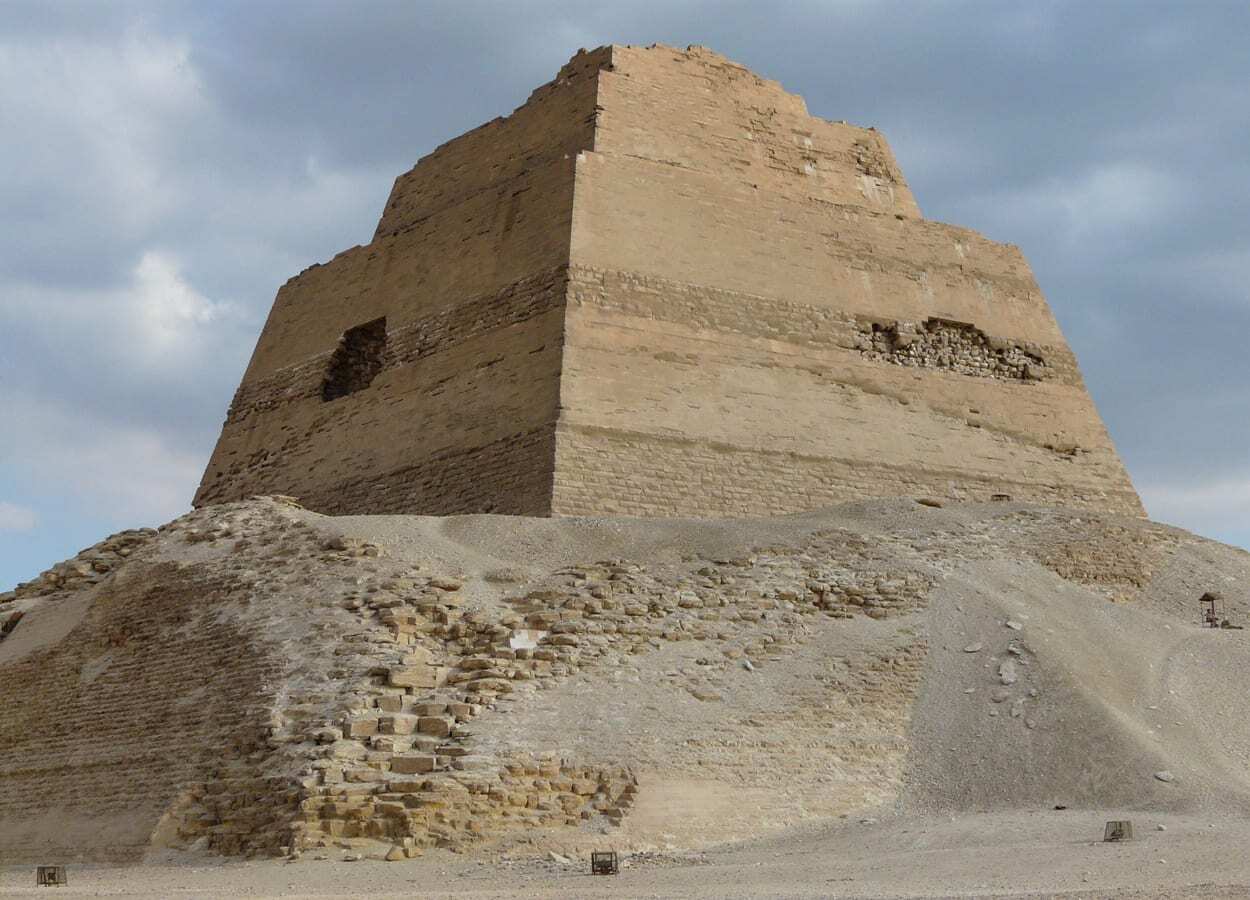
The Bent Pyramid (Original height 104.7 metres)
The Bent Pyramid was a smooth-sided pyramid constructed by Sneferu at the Dahshur necropolis. The pyramid is unique amongst other pyramids found in Egypt, due to its "bent" appearance by the change in the pyramids angle during construction. Some academics theorise that the change in angle was due to the collapse of the Pyramid of Meidum, or that the Bent Pyramid also began to show signs of instability during construction.
The substructure is simpler in design consisting of two entrances leading to chambers with a high corbelled roof. A hole in the roof of the northern chamber leads via a passage to the western entrance that connects to the main burial chamber.
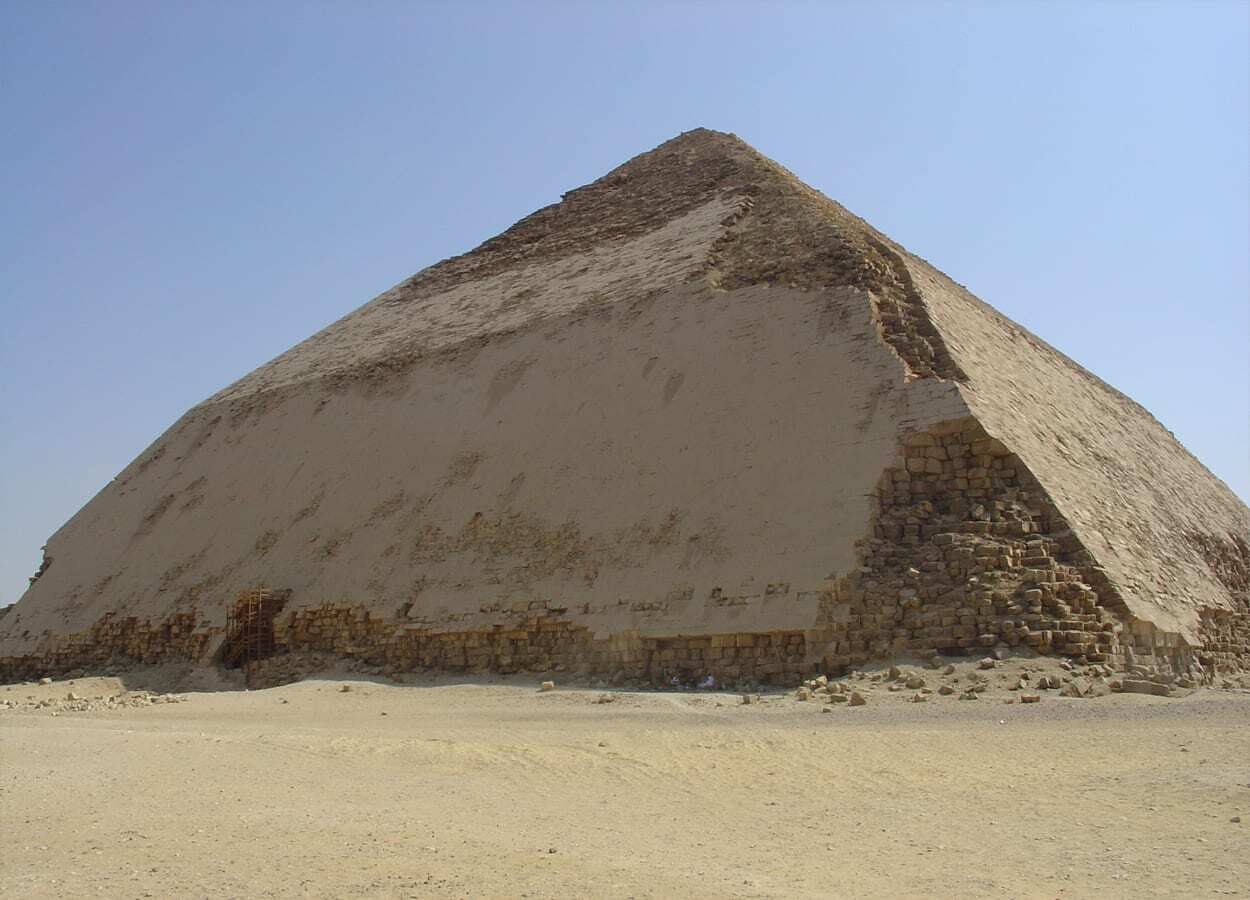
The Red Pyramid (Original height 105 metres)
The Red Pyramid, also called the North Pyramid was also constructed by Sneferu at the Dahshur necropolis and is considered the first successful attempt at constructing a "true" smooth-sided pyramid. Despite being called the Red Pyramid, the pyramid did not always appear red and was originally encased with a white Tura limestone.
The substructure consists of a long descending staircase that leads to a corbelled chamber and a passage connecting a second chamber. This contains another small short horizontal passage leading to the third and final chamber.

The Great Pyramid of Giza (Original height 146.7 metres)
The Great Pyramid of Giza, also known as the Pyramid of Khufu was built by the pharaoh Khufu, son of Sneferu and the second pharaoh of the 4th Dynasty. The pyramid was constructed in the Giza Necropolis on the Giza Plateau and would later be listed as one of the "Seven Wonders of the Ancient World". After the pyramid's completion, the Great Pyramid of Giza would remain the tallest man-made structure in the world until the completion of Lincoln Cathedral in England in AD 1311.
Inside the pyramid are three known chambers, the lowest being a rock-cut chamber in the bedrock which appears unfinished. In the superstructure are the Queen's and King's chamber, with recent studies detecting a large cavity above the Grand Gallery. Surrounding the pyramid are two mortuary temples, three smaller pyramids for Khufu's wives, a satellite pyramid and several mastabas for high-status officials and nobles.
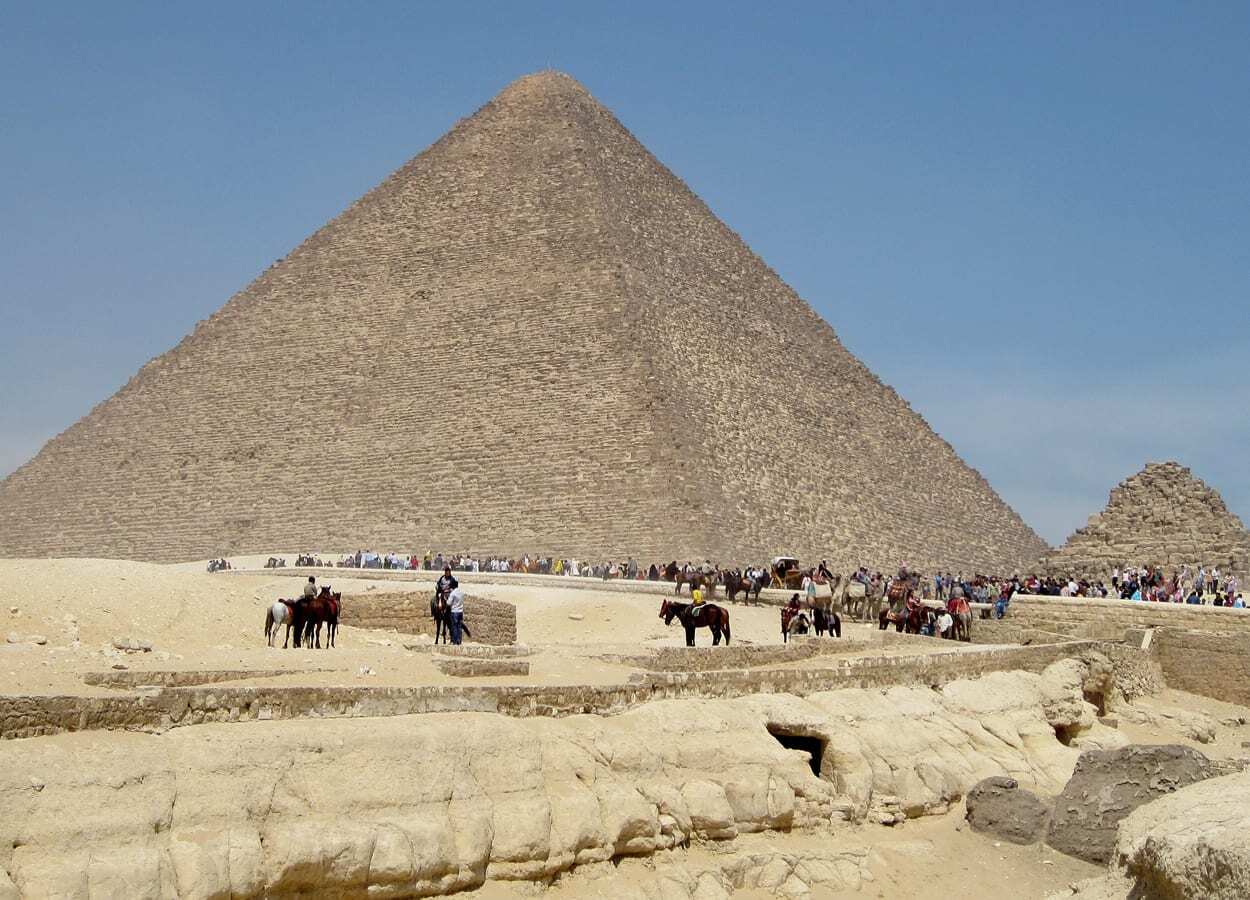
The Pyramid of Djedefre (Original height 67 metres)
The Pyramid of Djedefre was constructed by Djedefre, the son of Khufu during the 4th Dynasty at the plateau of Abu Rawash and would have been similar in size to the later Pyramid of Menkaure at the Giza Necropolis.
The pyramid broke from traditional pyramid construction, in that all the chambers were constructed beneath the pyramid using a building method known as "pit and ramp".
Some academics theorise that the pyramid was left unfinished due to Djedefre's short reign as pharaoh, whilst others suggest that the pyramid's stone was removed by the Romans for construction projects after the conquest of Egypt by Emperor Augustus.
The Unfinished Northern Pyramid of Zawyet El Aryan (Original height n/a metres)
The Unfinished Northern Pyramid of Zawyet El Aryan, also called the Pyramid of Baka are the remains of a 4th Dynasty pyramid that was abandoned early on during construction at Zawyet El Aryan.
Virtually nothing is known about the pyramid superstructure, nor are the details of the pharaoh who commissioned construction (although some scant evidence suggests Djedefre). The pyramid does, however, provide archaeologists are a unique insight into the building techniques at the heart of a pyramid prior to the superstructure construction, revealing a T-shaped shaft with steep stairways leading down to a burial chamber.
The Pyramid of Khafre (Original height 143.5 metres)
The Pyramid of Khafre was built by the 4th Dynasty pharaoh Khafre, son of Khufu and the throne successor of Djedefre. The pyramid is the second largest constructed at the Giza Necropolis, being built using horizontal courses, with the outer layers encased in pink granite for the lower courses and Tura limestone for the upper.
The pyramid is shorter in height than the Pyramid of Khufu, but to give the appearance of surpassing his father, Khafre built his pyramid on a layer of bedrock 10 metres higher. The interior of the pyramid is also simpler, consisting of two entrances that lead to the burial chamber cut from the bedrock, and a subsidiary chamber that may have functioned as the pharaohs serdab.
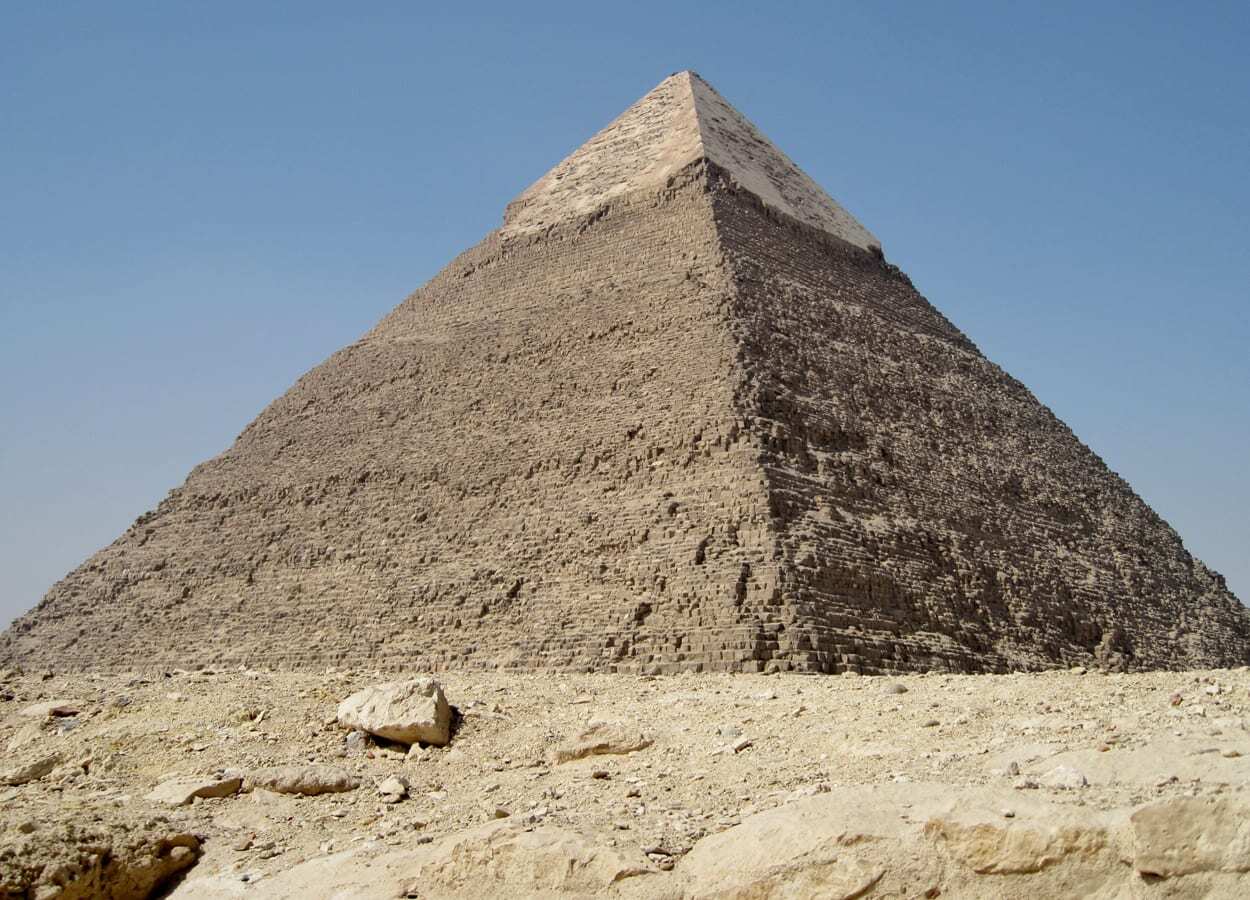
The Pyramid of Menkaure (Original height 65 metres)
The Pyramid of Menkaure is the smallest of the main three pyramids at the Giza Necropolis and was built by Menkaure, a 4th Dynasty pharaoh and possible successor to Khafre. The pyramid was constructed of Tura limestone and red Aswan granite and consists of a single entrance that leads to a series of inner chambers.
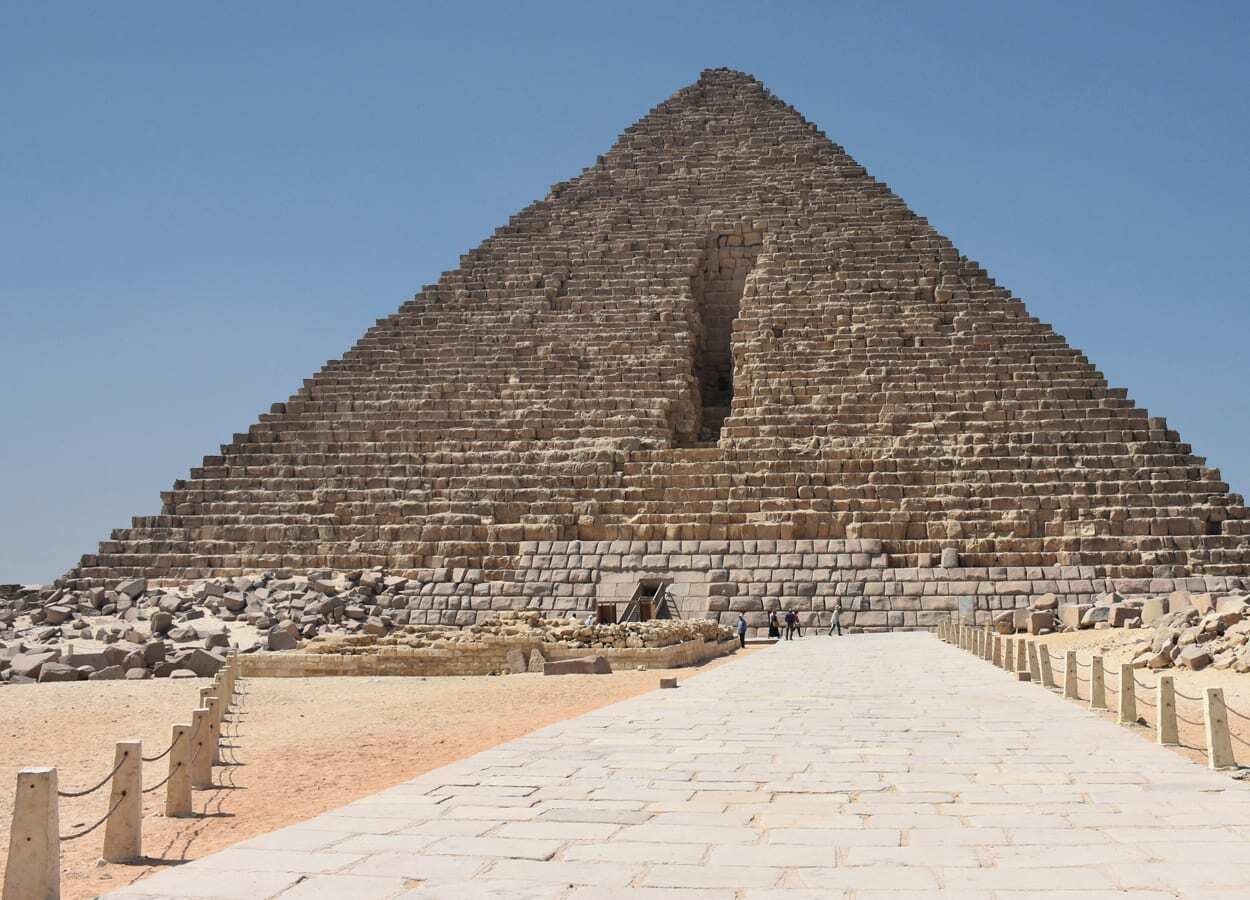
The Pyramid of Userkaf (Original height 49 metres)
The Pyramid of Userkaf was constructed by the pharaoh Userkaf, the founder of the 5th Dynasty, although he probably belonged to a branch of the 4th Dynasty royal family. The pyramid is located in the pyramid field at Saqqara and was a simpler construction to the precursor pyramids, being built with a core of rubble encased in dressed stones and is significantly smaller than previous pyramid monuments.

The Pyramid of Sahure (Original height 47 metres)
The Pyramid of Sahure was constructed by Sahure, who was the second pharaoh of the 5th Dynasty and possibly the son of Userkaf.
The pyramid is located in Abusir and consists of a main pyramid, mortuary temple, a valley temple on Abusir Lake, and a causeway linking the complex. This layout would become the newly adopted form for pyramid construction by succeeding pharaohs during the 5th and 6th Dynasty.
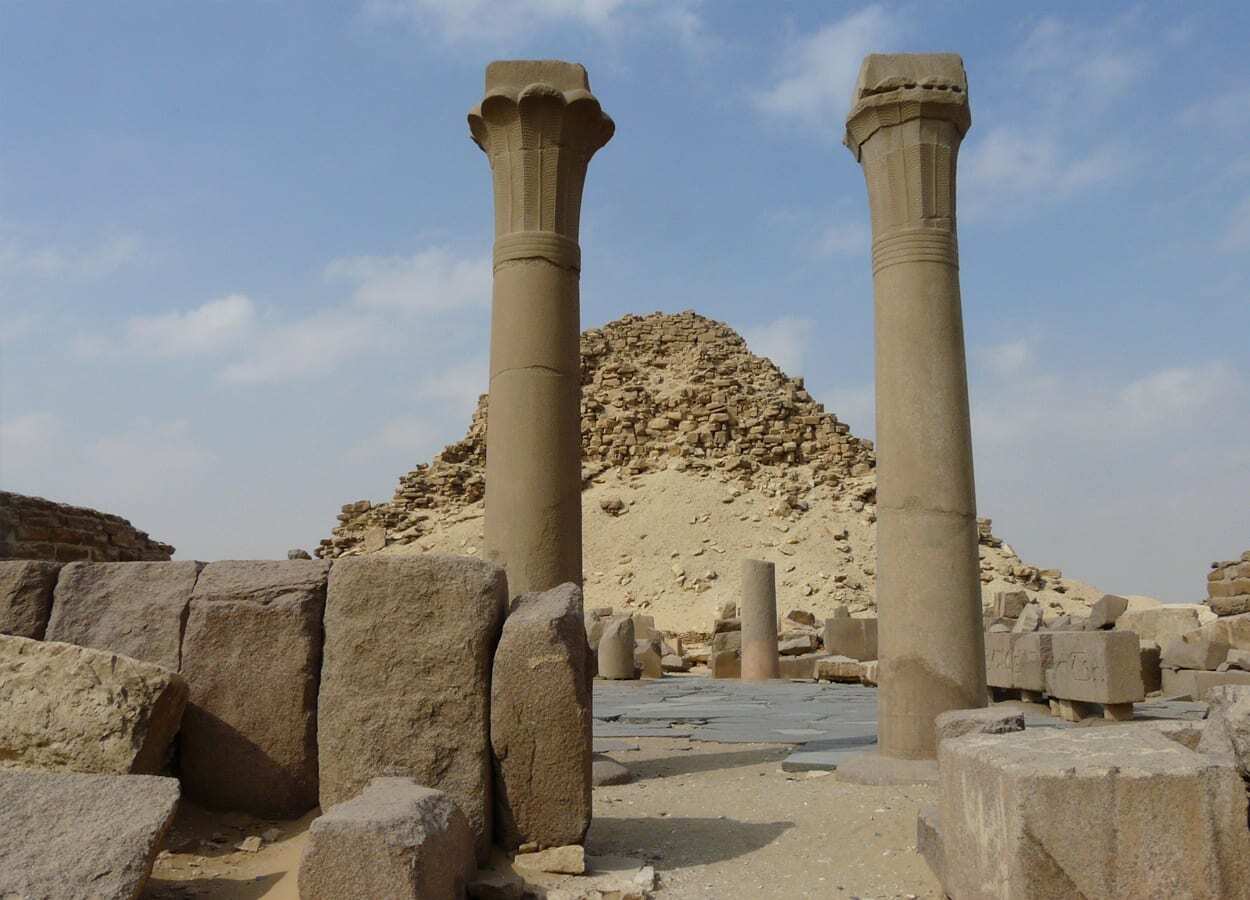
The Pyramid of Neferirkare (Original height 52 metres)
The Pyramid of Neferirkare was built at Abusir for Neferirkare Kakai, the third pharaoh of the 5th Dynasty and was the tallest structure located on the highest point at the Abusir necropolis.
The pyramid builders reverted to the earlier step pyramid design, then encased in a second step pyramid, with alterations intended to convert the monument into a true pyramid form reaching a similar size to the Pyramid of Menkaure.
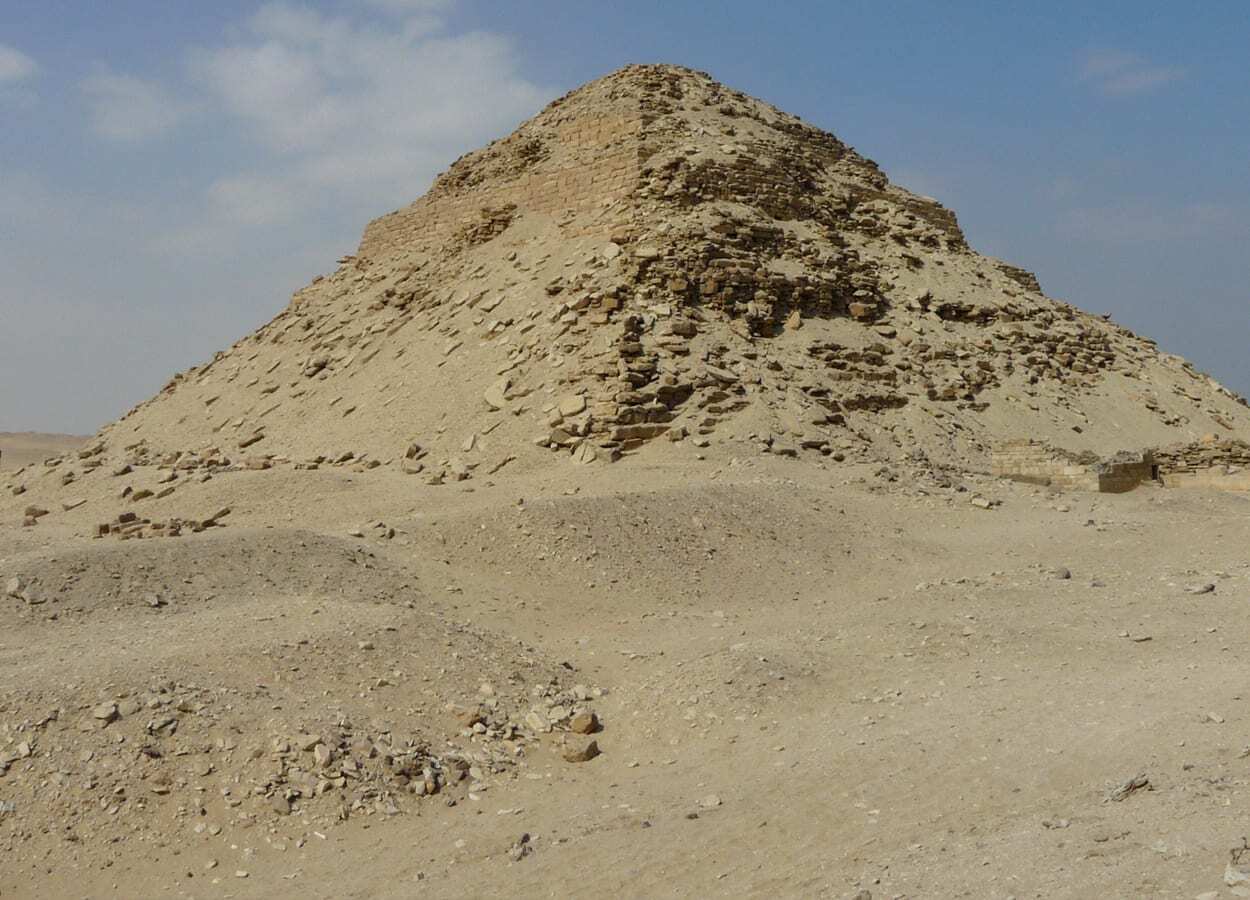
The Pyramid of Neferefre (Original height 65 metres)
The Pyramid of Neferefre, also called the Pyramid of Raneferef was constructed for Neferefre Isi, a 5th Dynasty pharaoh and most likely the eldest son of Neferirkare Kakai.
The pyramid was never finished and was converted into a mastaba after Neferefre's early death. The single-step was enclosed by roughly dressed fine white Tura limestone blocks that covered an entrance leading to an antechamber and burial chamber.
The Pyramid of Shepseskare (Intended height 73 metres)
The Pyramid of Shepseskare is an unfinished pyramid built for Shepseskare, the fourth or possibly fifth pharaoh of the 5th Dynasty. The pyramid is located in the Abusir necropolis and appears to have been abandoned shortly after construction began, consisting of a levelled square area and a T-shaped ditch at the centre.
The Pyramid of Nyuserre (Original height 51.6 metres)
The Pyramid of Nyuserre was constructed for Nyuserre Ini, the sixth ruler of the 5th Dynasty and was the younger son of Neferirkare Kakai. The pyramid was built in the Abusir necropolis and comprised of seven ascending steps anchored on cornerstones and encased with Tura limestone.

The Headless Pyramid (Original height n/a metres)
The Headless Pyramid was built for the pharaoh Menkauhor Kaiu, the 7th ruler of the 5th Dynasty at the Saqqara necropolis. Originally named Netjer-isut-Menkauhor by the Ancient Egyptians, meaning "The divine places of Menkauhor", virtually nothing remains of the pyramid's superstructure today.
The Pyramid of Djedkare Isesi (Original height 52.5 metres)
The Pyramid of Djedkare Isesi was constructed by Djedkare Isesi, the 8th ruler of the 5th Dynasty at the southern end of the Saqqara necropolis. Originally named Nefer-Djed-ka-re by the Ancient Egyptians, meaning "Beautiful is Djedkare", the pyramid consisted of a six-stepped core built from roughly cut limestone bound together by clay mortar and encased in Tura limestone.
Adjacent to the pyramid complex, a satellite pyramid complex was built for Djedkare's wife, Queen Setibhor, the largest complex of its kind for any queen during the Old Kingdom.
The Pyramid of Unas (Original height 43 metres)
The Pyramid of Unas was built for the pharaoh Unas, the ninth and final pharaoh of the 5th Dynasty. The pyramid was constructed in the northern part of the Saqqara necropolis, resulting in the removal of various earlier buildings and tombs to make way for Unas's funerary complex.
Although Unas's reign lasted for more than 30 years, his pyramid was one of the smallest built during the Old Kingdom. Despite the size, the pyramid is one of the most significant pyramids with the discovery of the first pyramid texts, spells for the pharaoh's afterlife incised into the walls of its subterranean chambers.
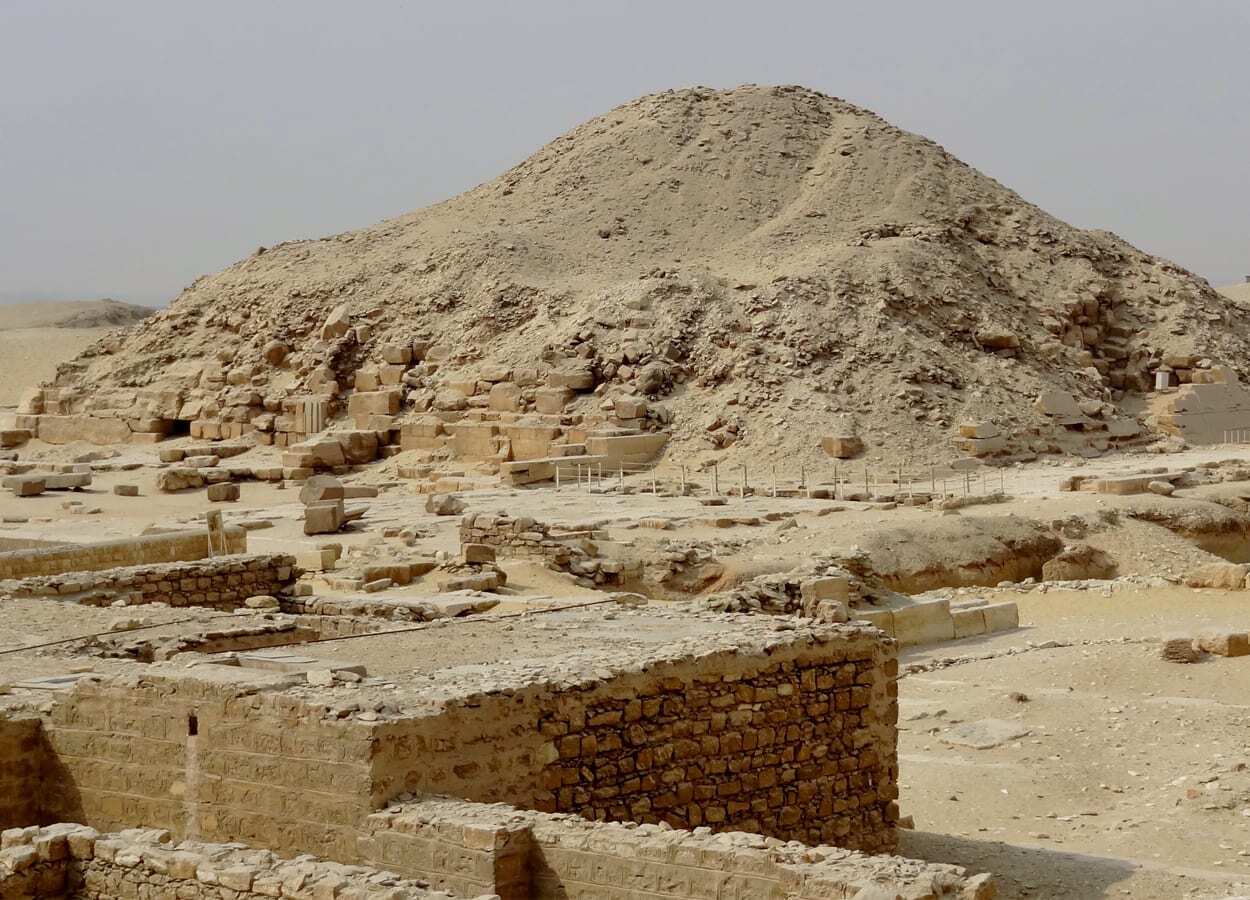
The Pyramid of Teti (Original height 52.5 metres)
The Pyramid of Teti was constructed for Teti, less commonly known as Othoes, the first pharaoh of the 6th Dynasty. The pyramid was built in the Saqqara necropolis but the poor preservation above ground has resulted in the pyramid resembling a small natural hill. A single entrance leads to a series of chambers consisting of a funeral serdab, an antechamber and a burial chamber, all of which also contain inscribed pyramid texts.
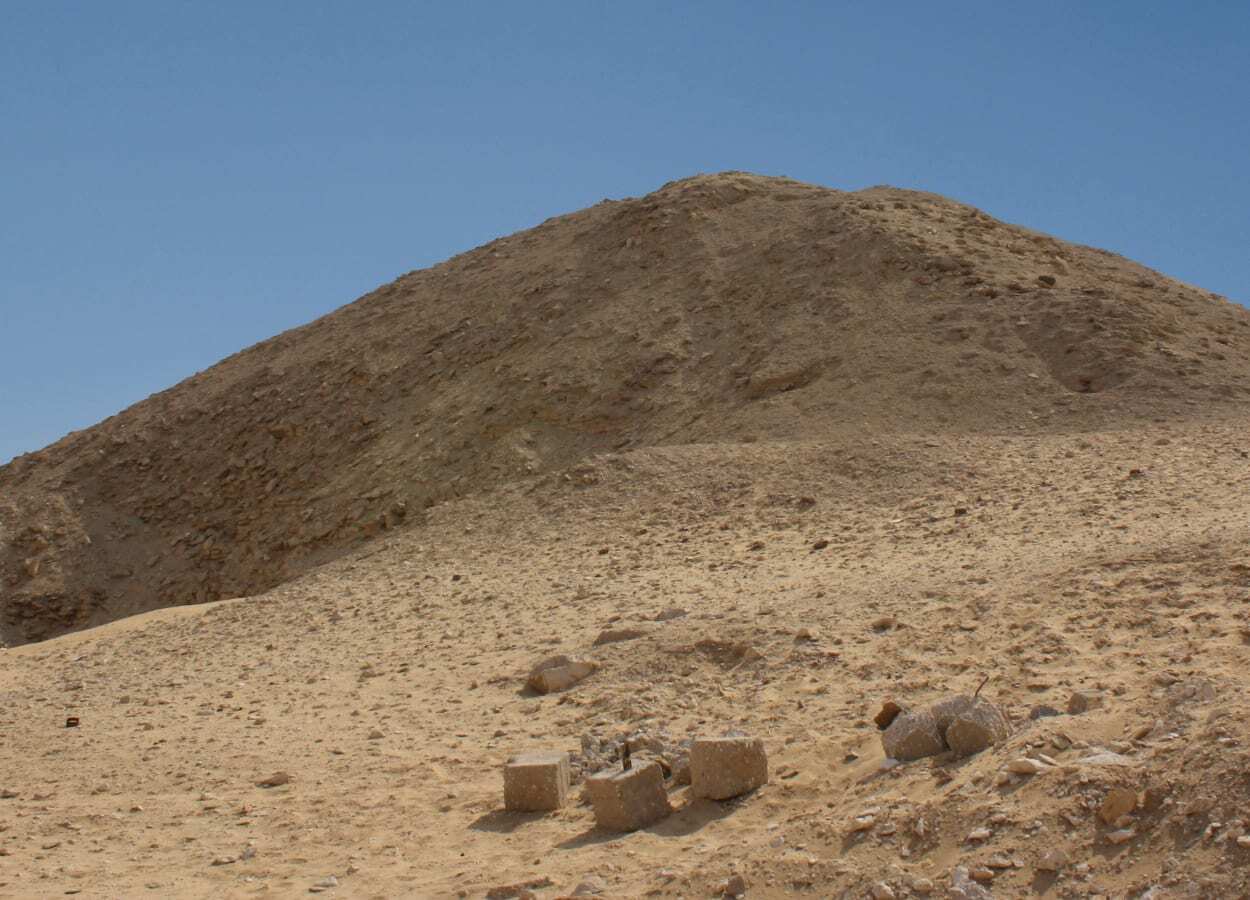
The Pyramid of Pepi I (Original height 52.5 metres)
The Pyramid of Pepi I was built for the pharaoh Pepi I Meryre, the son of his second predecessor Teti, ruling Egypt during the 6th Dynasty. The pyramid was constructed in the Saqqara necropolis and replicated the basic design of Djedkare-Isesi's funerary complex with a core that was constructed with six steps and encased with white Tura limestone.
The walls of Pepi I's antechamber, burial chamber, and corridor were inscribed with vertical columns of green painted hieroglyphic text and the ceiling was painted with white stars, oriented to the west against a black background.
The Pyramid of Merenre (Original height 52.6 metres)
The Pyramid of Merenre was built for the pharaoh Merenre Nemtyemsaf I, the fourth pharaoh of the 6th Dynasty in the Saqqara necropolis. Little remains of the pyramid superstructure and surrounding complex, which now resembles a small natural hill. The pyramid substructure consists of a vestibule, antechamber, a small serdab, and a burial chamber decorated with an astrological theme.
The Pyramid of Pepi II (Original height 52.5 metres)
The Pyramid of Pepi II was constructed in the Saqqara necropolis for Pepi II Neferkare, a pharaoh of the 6th Dynasty. Despite the longevity of Pepi II's reign, his pyramid was no larger than those of his predecessors and was built from small local stones and infill, covered with a veneer of limestone.
The Pyramid of Ibi (Original height 21 metres)
The Pyramid of Ibi was built for Qakare Ibi, the 14th pharaoh of the 8th Dynasty and is located in the Saqqara necropolis. The pyramid is very small in size, comparable to the dimensions and decorations of the pyramids built for the queens of Pepi II.
The Pyramid of Khui (Original height n/a metres)
The Pyramid of Khui was constructed at Dara for the minor pharaoh Khui, a kinglet or self-proclaimed king who ruled during the 8th Dynasty. The exterior form of the superstructure is disputed as to whether it was intended to be a true pyramid, step pyramid or mastaba. It was built using mudbrick walls that slant inwards, which now hold an empty inner space that may have previously been filled with sand and gravel.
The Pyramid of Amenemhet I (Original height 59 metres)
The Pyramid of Amenemhet I was built for Amenemhet I, the first pharaoh of the 12th Dynasty. The pyramid was constructed near Lisht after moving the capital from Thebes and is considered a return to the size and form of the Old Kingdom pyramids builders.
The core of the pyramid was made using rough blocks of limestone with a loose fill of sand and mud brick. Some of the limestone used in the construction was robbed building material that was taken from the pyramids of Khufu, Khafre, Unas and Pepi II.

The Pyramid of Senusret I (Original height 61.2 metres)
The Pyramid of Senusret I was constructed for Senusret I, the second pharaoh of the 12th Dynasty and is located near Lisht.
The pyramid builders tried to pioneer a new method of construction, using four stone walls radiated from the centre that decreased in size with each course added. This created 8 sections that were then subdivided by more walls, creating 32 different "units" that were filled with stone and rubble. Although experimental, this method caused the structure to suffer from stability issues due to indifferent weight distribution.
The White Pyramid (Original height n/a metres)
The White Pyramid was constructed at Dahshur, and was possibly built for Nubkaure Amenemhat II, the third pharaoh of the 12th Dynasty. Little remains of the pyramid's superstructure due to quarrying of the site for limestone and a full-scale investigation of the whole complex is yet to be undertaken.
The Pyramid of Senusret II (Original height 48.6 metres)
The Pyramid of Senusret II was built at Illahun for Senusret II, the fourth pharaoh of the 12th Dynasty.
The pyramid was constructed on a rock outcrop with a yellow limestone stump and surrounding mudbrick core that was encased in white limestone. The substructure contains a labyrinth of passageways connecting chambers with the main burial chamber and antechamber.

The Pyramid of Senusret III (Original height 78 metres)
The Pyramid of Senusret III is located at Dahshur and was constructed for Senusret III, the fifth pharaoh of the 12th Dynasty.
It was erected on levelled ground and composed of a mudbricks core covered with a casing of white Tura limestone blocks resting on foundations. The substructure consists of a long descending hallway that leads to an antechamber that connects storerooms and the main burial chamber.
The Black Pyramid (Original height 75 metres)
The Black Pyramid, called the Pyramid of Amenemhat III was constructed at Dahshur for Amenemhat III, a pharaoh who ruled during the 12th Dynasty. The Black Pyramid was the first pyramid intended to house both the deceased pharaoh and his queens (who were usually buried in smaller satellite pyramids as part of the pharaohs funerary complex).
The pyramid was constructed using mudbrick and clay encased in limestone, but the pyramid suffered stability issues causing the superstructure to sink under the immense weight. The substructure consisted of a complex layout of tunnels, with separate burial chambers for the pharaoh and his wives, but the pyramid was abandoned after it began to crush the underground chambers.

The Pyramid of Hawara (Original height n/a metres)
The Pyramid of Hawara was also constructed by Amenemhat III at Hawara, possibly because of the failed pyramid at Dahshur.
The pyramid was also built from mudbrick, around a limestone core and was encased in limestone. The substructure consists of a large burial chamber with an arched roof, a series of chambers and three dead-end chambers, each sealed with overhead blocks – the first known use of overhead gates in a pyramid.
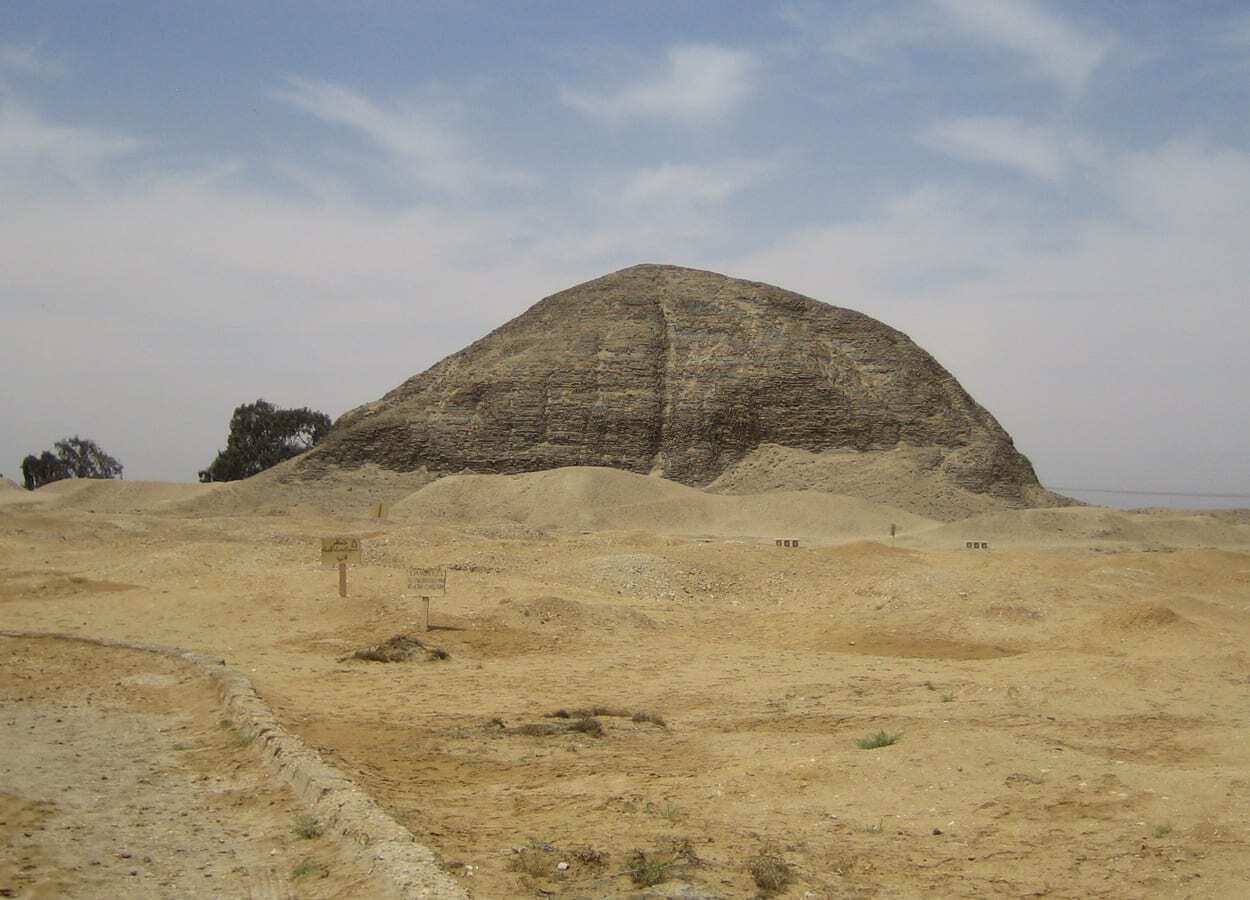
The Southern Mazghuna Pyramid (Original height 52.5 metres)
The Southern Mazghuna Pyramid is an unfinished pyramid that was being constructed at Mazghuna. The original pyramid builder is unknown but may have been commissioned by Amenemhat IV during the 12th Dynasty as it shares some structural similarities to the Hawara pyramid of Amenemhat III.
The subsystem consists of a long staircase that leads to a rectangular passage, followed by another staircase that descends to a U-shaped chamber system and the main burial chamber.
The Northern Mazghuna Pyramid (Original height n/a metres)
The Northern Mazghuna Pyramid is another unfinished pyramid located at Mazghuna that dates from either the 12th or 13th Dynasty (based on similarities with the Pyramid of Khendjer). Like the Southern Pyramid, the identity of the pharaoh that commissioned the construction is unknown but is possibly attributed to the female-pharaoh Sobekneferu, sister of Amenemhat IV and last ruler of the 12th Dynasty.
Pyramid of Ameny Qemau (Original height 35 metres)
The Pyramid of Ameny Qemau is located in southern Dahshur and was constructed for the pharaoh Ameny Qemau during the 13th Dynasty.
Little remains of the pyramid's superstructure and the substructure is in a ruinous state, consisting of a series of chambers that leads to a small staircase and the main burial chamber.
The Pyramid of Khendjer (Original height 37.3 metres)
The Pyramid of Khendjer was constructed for the pharaoh Userkare Khendjer, who was the twenty-first pharaoh of the 13th Dynasty and is located south of the Saqarra necropolis.
The pyramids superstructure is mainly in ruins, built with a mudbrick core and a limestone outer casing that has been subsequently robbed leaving the pyramid now only one meter tall. The substructure consists of a long staircase and a series of chambers in a U shape, leading to the main burial chamber that had interconnecting chambers.
The Southern South Saqqara Pyramid (Original height n/a metres)
The Southern South Saqqara Pyramid is an unfinished pyramid built for an unknown pharaoh during the 13th Dynasty south of the Saqqara necropolis.
The pyramid contains one of the most complex subsystems from any pyramid built during the 12th and 13th Dynasty, consisting of a passageway that changes direction and levels several times.
The Pyramid of Ahmose (Original height 40 metres)
The Pyramid of Ahmose was built as a cenotaph for the 18th Dynasty pharaoh Ahmose I at the necropolis of Abydos. The pyramid was constructed from sand and rubble encased in limestone but contains no substructure as the monument was never intended to be a tomb. Around the pyramid were a number of temples and also a small cenotaph pyramid for Ahmose's grandmother Tetisheri.
Header Image Credit : zolakoma
-- Sent from my Linux system.
No comments:
Post a Comment